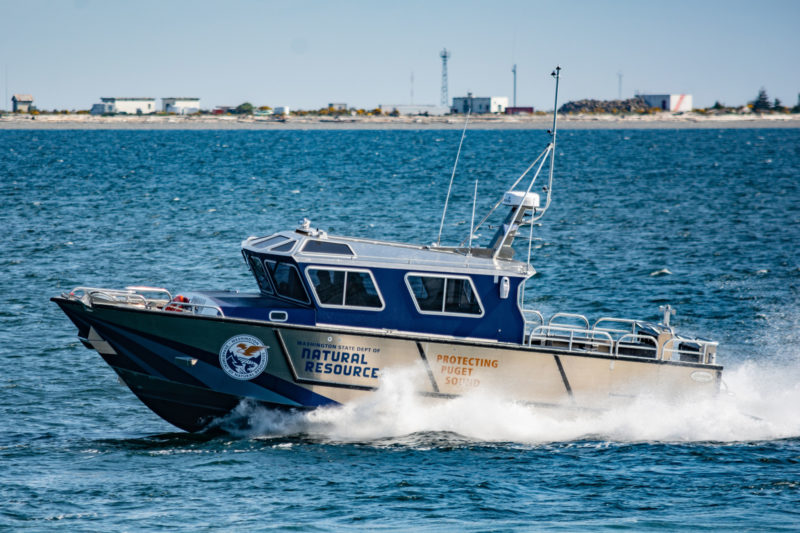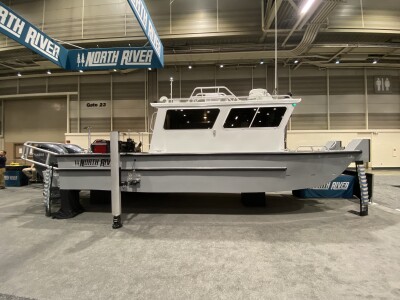The 38'x13' monohull dive compliance vessel Salish Scout was recently accepted by the Washington State Department of Natural Resources (DNR) after successful launch and sea trials in Port Angeles Harbor. In a competitive solicitation process last year, DNR selected Port Angeles-based Armstrong Marine USA’s proposal to design and build multiple vessels for its Marine Law Enforcement program. Salish Scout is a sistership to the vessel Sentry, completed earlier this summer.
The boat is customized for efficient geoduck fishery management along with other marine law enforcement operations. A 4' dive platform, tank racks, aft deck shower, and custom dive ladder serve DNR divers monitoring geoduck stock and habitat.
Twin Cummins QSB6.7 425 hp engines in a semi-tunnel straight shaft arrangement achieve 24 knot cruise and 30 knot pursuit speeds. SeaStar/Teleflex steering with Capilano helm pump, an Imtra Side-Power bowthruster, Bennett electric trim tabs, and Garmin navigation package with autopilot complete the system, ensuring superior maneuverability around other boats. Two 180-gal. fuel tanks allow for long hours on station, while an offset windlass eases repeated anchoring. Salish Scout is also outfitted with two tow bollards, 3-inch D-rubber fendering, and Rigid LED flood lights.
Inside the heated walk-around cabin, six Bentley’s Mariner seats with heavy duty suspension bases accommodate captain and crew. Two folding tables and a storage cabinet lend versatility to the interior workspace. AJR Marine overhead spotter windows maximize visibility. A sliding half door at the helm offers quick operator access during mooring. The pass-through cuddy provides bow access and emergency egress in addition to housing the head and ample equipment storage shelving.
“As the manager of 2.6 million acres of aquatic lands, the Department of Natural Resources plays a critical role in protecting our waters and preserving habitat from those who seek to damage it,” Commissioner of Public Lands Hilary Franz said in a statement announcing the delivery. “Sentry and Salish Scout will be DNR’s first line of defense against derelict vessels, abandoned fishing gear, and plastics that pollute our waters. Built by Armstrong Marine USA right here in Washington, these boats and their crews will assist recreational boaters and enforce the laws that keep our natural resources healthy and productive.”
The aggressive lines of Armstrong Marine’s design lend presence well-suited for compliance missions. Armstrong partnered with DNR’s graphic designer to complement the boat’s look with vinyl graphics fitting of an official agency enforcement vessel.
“Sentry and Salish Scout have met all targets set for performance, use, and serviceability. We’re proud that both vessels have entered service right away and are now contributing in such a significant way to DNR’s marine law enforcement missions,” said Armstrong Marine USA managing director Perry Knudson.
Armstrong is also scheduled to deliver a 42'x16'x5' aluminum planing catamaran research vessel to Orca Maritime, San Diego.
The new workboat, designed and built at Armstrong Marine USA, will have a draft of 2', a range of 800 kilometers (500 nautical miles), a cruising speed of over 25 knots and a top speed of 37 knots. There will be work space for six scientists and a boat operator. The vessel will sport an A-frame for lifting up to 4,000 lbs., an adaptable deck foundation for configuring and securing technology, and a computer-controlled engine system to automatically maintain position and heading, which will be useful for the range of research and technology development anticipated onboard.
Orca Maritime will utilize the workboat in support of the U.S. Navy’s unmanned underwater systems programs in San Diego. Work will include the launch and recovery of autonomous underwater vehicles (AUV), underwater gliders, surface and underwater sensors, remotely operated vehicle (ROV) operations, unmanned surface vehicles (USV), the deployment and recovery of underwater training mines, and surface-supplied and SCUBA diving operations.
The boat will have a rear cargo deck measuring 19'3"x13'1" with recessed all thread tie down points. Capacities will include 600 gals. of fuel and 55 gals. water.
Main propulsion for the research vessel will come from twin Volvo Penta D11 engines, producing 510 hp at 2,250 rpm each. The mains connect to forward facing duo props through Volvo IPS transmissions with 1.70:1 reduction ratios. Volvo also handled the manufacturing of the controls and steering system. Ship’s service power is the responsibility of a 9-kW Northern Lights 3-phase generator.
The boat will also be fitted with a Kinematics hydraulic winch and the Pullmaster PL5 A-frame mounted hydraulic winch.
By adding the vessel to their fleet, Orca Maritime will be better equipped to conduct multi-day operations along the Southern California coast.





